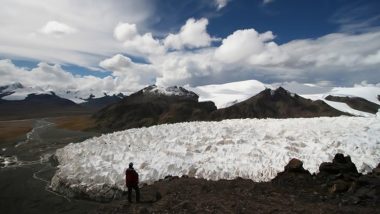Lhasa [Tibet], June 27: Around 17,555 Tibetan people will be relocated away from high-altitude places in Nagqu City, southwest China's Tibet Autonomous Region under a relocation plan that aims to improve the living conditions of the people and protect the region's fragile ecosystem.
In the next one and half months, the people will move from places with an average altitude of over 4,500 meters above sea level to more hospitable areas of about 3,600 meters in Shannan City, Xinhua reported. Punjab Budget 2022–23: AAP Govt To Give 300 Units of Free Electricity to Households From July 1.
Regional forestry and grassland administration Director Wu Wei stated that the people in the city had lived in places with harsh weather and relatively backward production and living conditions, where the grassland degraded.
"The relocation scheme reflects a people-centered development thought, taking consideration of both the ecological protection and people's demand for a better life," Wu added.
More than 130,000 people in around 100 Tibet towns will be covered under the relocation plan in eight years, the media added.
This comes after a recent White Paper of Tibet titled 'Tibet since 1951: Liberation, Development and Prosperity from Beijing' highlighted very clearly how there was no concern about the level of destruction to Tibet's environment, reported Tibet Press.
The nature-bound systems of Tibet are now being shattered and destroyed by Beijing for their own benefit, not even giving an iota of thought to the inhabitants.
Instead of acknowledging the environmental destruction in Tibet, it painted a good light on the government by wanting to take eco-friendly and sustainably motivated steps moving forward.
All of these eventually lead to the drying up of rivers, glacial melting, thawing of permafrost, flooding, loss of grasslands and many more - all occurring due to the environmental destruction in Tibet under the hawkish eyes of president Xi Jinping, reported Tibet Press.
Since the 1959 Uprising, the central government of China has been steadily tightening its grip on Tibet. In Tibet today, there is no freedom of speech, religion, or press and arbitrary detainments continue.
Forced abortion, sterilisation of Tibetan women, and the transfer of low-income Chinese citizens threaten the survival of Tibetan culture.
Although China has invested in infrastructure improvements for the region, particularly in Lhasa itself, it has also encouraged thousands of ethnic Han Chinese to move to Tibet resulting in a demographic shift.
Furthermore, Beijing which currently governs Tibet sees the latter as a dump zone rather than a safe haven and does not provide the required resources to protect this very fragile but significant eco-system and unique biome, the local media reported.
Tibet experiences the harsh reality of climate change through environmental destruction and degradation advocated by policies from Beijing.
The melting glaciers of Tibet are worrying and troublesome for all the regions that depend on it as their ultimate source of water.
Over 1.5 billion people across the continent of Asia rely on Tibet for their source of water since the largest rivers in Asia such as the Brahmaputra, the Ganges, the Mekong and the Yangtze all flow from Tibet.
(The above story is verified and authored by ANI staff, ANI is South Asia's leading multimedia news agency with over 100 bureaus in India, South Asia and across the globe. ANI brings the latest news on Politics and Current Affairs in India & around the World, Sports, Health, Fitness, Entertainment, & News. The views appearing in the above post do not reflect the opinions of LatestLY)













 Quickly
Quickly


